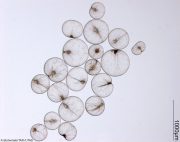document
Type of resources
Topics
Keywords
Contact for the resource
Provided by
Years
-
This document describes the management and QA/QC processes for the National Reef Monitoring Network (NRMN) data. The NRMN provides publicly accessible data for shallow reef biodiversity on a global scale, integrating high quality compatible data from long-term scientific monitoring programs and citizen science programs globally.
-

The Guide to the Marine Zooplankton of south eastern Australia, is an interactive tool providing a comprehensive, fully illustrated means of identification for the major zooplankton located in south eastern Australia. This new identification guide to local marine zooplankton is available online at: http://www.imas.utas.edu.au/zooplankton This is the result of collaboration between the Marine Research Laboratories and School of Zoology, University of Tasmania, and the Australian Antarctic Division. Please note that the full contents of the site will be available on (Free) CD-Rom
-
The prolonged rainfall reduction in South West Western Australia (SWWA) in recent decades has previously been reported to be unprecedented in the past 750 years. This rainfall reduction has reduced the water supply for both residents and agriculture in SWWA. However, the cause of this rainfall reduction is unclear. The relatively short length of the SWWA instrumental rainfall record limits long term studies of SWWA rainfall. In this study, SWWA rainfall is reconstructed based on a statistically significant negative correlation between SWWA rainfall and snowfall at Dome Summit South (DSS), East Antarctica. The 2000-year DSS snow accumulation record is used to reconstruct SWWA rainfall from 22 BCE to 2015 CE. With Cumulative Summation (CUSUM) analysis applied to the rainfall reconstruction, it is found that SWWA rainfall started to reduce around 1971 CE. This prolonged rainfall reduction is unprecedented during the past 750 years, but there have been two prior droughts of similar duration and intensity during the past 2000 years. Applying statistical techniques to compare the rainfall reconstruction with climate model simulations, it is found that greenhouse gases are likely to be the dominant driver of the SWWA rainfall drying trend after 1971 CE. This record describes the Honours Thesis [available for download in 'Online Resources' section of thsi record]. For the data generated by this project, see https://metadata.imas.utas.edu.au/geonetwork/srv/eng/catalog.search#/metadata/d7d5ea56-f972-435d-b44b-44fea598150c
 IMAS Metadata Catalogue
IMAS Metadata Catalogue